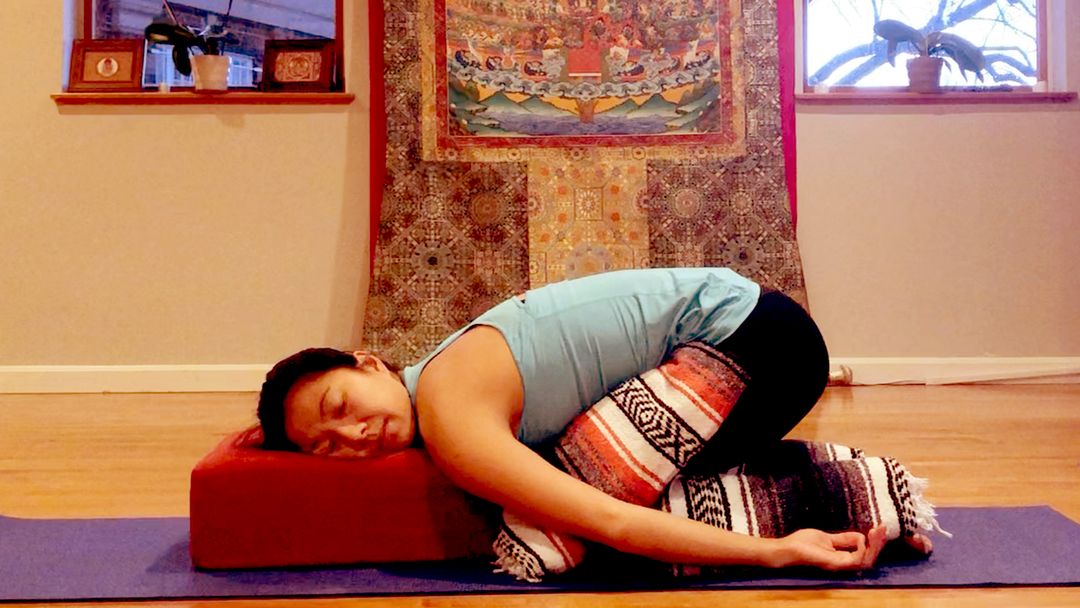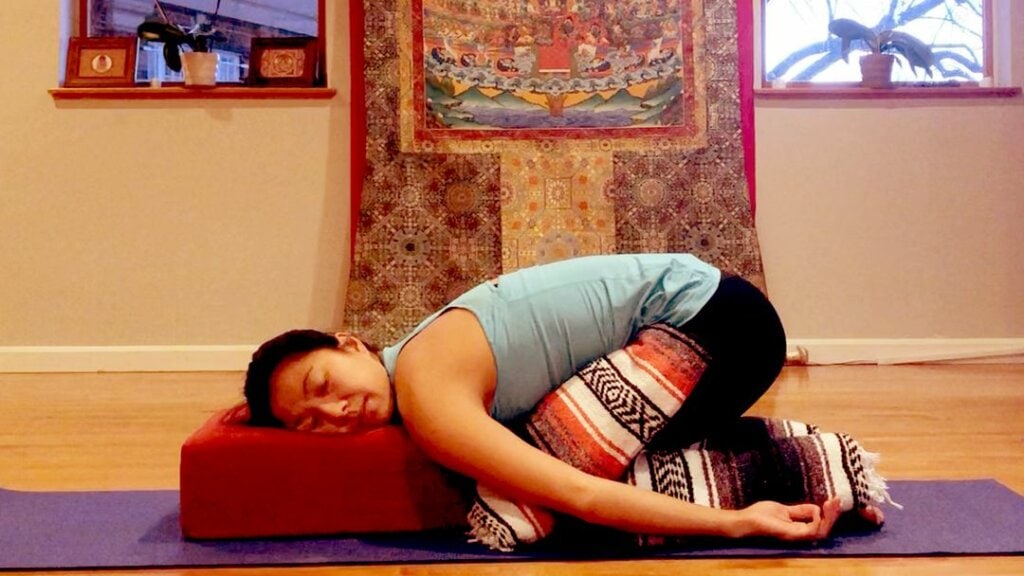The evanescence of a mindful release, slowly escaping like water trickling through your hands as you yearn to grasp it. Its paradoxical nature coyly teases our sense and sensibility. We are taught that working hard and gritting through difficult times will and should lead to successful results. Yet, the harder we grip and struggle to let go, the more evasive and enigmatic the release. So how do we learn to mentally let go and just be. Two simple phrases comprised for four short words that take us a long, lifetime love affair with ourselves.
Let’s start with this breath, inviting a moment of pause to inhale just be and exhale let go. In this moment, and every moment onward, we strive to remember we are enough and invite ourselves to just be.
These five yoga poses were curated to help you slow down, soften, and mentally release. Practice what you need, playing around with lengthening the time on your mat especially when it feels least convenient.
1. Supta Baddha Konasana (Reclining Bound Angle Pose) – Variation
There is a reason Supta Baddha Konasana is one of the most popular restorative poses. Shaped like an anchor, this heart opener and backbend can help you settle into your body and gently release your mind. There are numerous variations of this asana, in this offering you can rest your arms overhead. The arms overhead evokes an unconscious sense of safety as you protect your head as well as opens the highway of the armpits for deeper connection and release. A blanket rolled under the outer leg, principally the upper thigh, supports the muscles to work less and stretch more. If you have lower back pain, use a bolster (not pictured) to support the spine and place the bolster as close to the sacrum as possible. Hold for 5-20 minutes
2. Adho Mukha Svanasana (Downward-Facing Dog) – Variation
Practiced daily by millions of yogis, Adho Mukha Svanasana is a powerful asana that can feel far from restorative. It is incredible how blocks and props can transforms a practice. The blocks placed under the crown of the head exemplify Newton’s Third Law of Motion: for every action there is an equal and opposite reaction. As the head rests gently on the blocks, the blocks provide feedback and support to the body. An invitation to work less and foster a mental release. Hold for 3-10 comfortable breaths with focus on the crown of the head and a mental release.
3. Uttana Shishosana (Extended Puppy Pose) – Variation
While a puppy may stretch in a way that looks similar to this pose, it would be a misnomer to think this asana was named because of its cozy and cuddly quality. This intense stretch for the chest, shoulders, and armpits is a reminder that restorative does not equate to comfortable. A sensational pose that takes time to find steadiness (sthira) and ease (sukha). A blanket under the knees and shins can provide extra comfort for extended holds. If you have shoulder pain or a tight chest and back, practice without the blocks for a standard Uttana Shishosana. Hold for 2-5 minutes.
4. Balasana (Child’s Pose) – Variation
Named for how humans grow in the womb, Balasana is a common way to find babies and young children sleep. It is adorable and looks extremely peaceful for them. As we grow, our bodies change shape and distribute weight differently. We adjust our sleeping positions accordingly to changes in our body and environment. While we may no longer sleep like a baby, Balasana supported with bolsters and blankets can be a heavenly place to pause for a mindful release. In this variation, a blanket is placed between the calves and thighs to support the knees and another blanket is placed between the thighs and chest to support the lower back. If your feet are prone to falling asleep or you have knee pain, you can add another blanket under the shins. Hold for 5-10 minutes on one side, switch which cheek is on the bolster and hold another 5-10 minutes.
5. Supta Kapotasana (Supine Figure 4 Pose)
One of the many supine restorative asana that utilize the wall, Supta Kapotasana is especially helpful for individuals who would like to externally open their hips and knees but find pigeon pose unaccessible. In this variation, you can interlace your fingers and toes on the leg that is crossed in a figure four. As the yoga saying goes: open toes, open mind.
There is no set rule for how long you have to stay in each pose. Your body will speak to you as you slow down. Adjust to help this practice serve you, try to pause and practice for at least five minutes a day.








